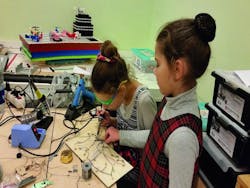European PHABLABS to tackle underrepresentation of women in photonics through STEM

According to the UNESCO Institute for Statistics (UIS), less than 30% of the world's researchers are women. However, a new outreach project has been tackling this underrepresentation by engaging young female minds with STEM, in the hope that they will pursue a career within the photonics, science or engineering industries.
Thousands of young women and girls have had the chance to explore the world of science, engineering, and light technologies thanks to a European photonics research consortium that has created their girls in STEM ecosystem, a series of 33 workshops and 11 Photonics Challenger projects across 10 European countries in a bid to tackle the underrepresentation of women in science.
Staged in ten countries across Europe, a total of 1221 girls have attended the ‘Phablabs 4.0’ initiatives since last year. The workshops have created novel and innovative problems for students to solve using lasers and photonics, the technology around the emission, manipulation and detection of light. Combining a ‘Fab Lab’—or a fabrication laboratory—with the world of photonics, the workshops and Challenger Projects offer a glimpse into careers in photonics, engineering, computer coding, and robotics.
Students have been exploring tasks as varied as creating an artwork made from lasers, modifying a cuddly toy with photonics, or building an infrared glove that acts as a remote control where touching two fingers creates a signal.
The more advanced Challenger Projects have tasked students with building an Invisibility Cloak or creating their own hologram. Some students, like Ester Muylaert, 18, from Halle, Belgium, are really excited to discover material they would not learn anywhere else.
“Phablabs is amazing and interesting. We’ve learned lots of new skills that we wouldn’t have picked up in school. To see the job in front of me and to meet the person who does that job has given me loads of ideas about what I can do in the future. It’s really made me want to work with photonics.”
The researchers have targeted three age categories with workshops aimed at high school girls (Young Minds), female university students (Students) and women who may have already started their careers (Young Professionals 18+).
Supported by the Gender Action Team, the developers have had the backing of the European Commission with funding from Horizon 2020, and support from a number of professionals such as Professor Averil MacDonald from WISE (Women in Science and Engineering).
“We are delighted to be able to open a door into a world of science that some girls and young women may feel is closed,” professor MacDonald said. “Girls and young women are more likely to consider studying STEM subjects beyond age 16 if they see that the subject keeps their options open.”
The resources are available as an open resource toolkit for educators to use with their students.
SOURCE: PHABLABS; http://www.phablabs.eu/
About the Author

Gail Overton
Senior Editor (2004-2020)
Gail has more than 30 years of engineering, marketing, product management, and editorial experience in the photonics and optical communications industry. Before joining the staff at Laser Focus World in 2004, she held many product management and product marketing roles in the fiber-optics industry, most notably at Hughes (El Segundo, CA), GTE Labs (Waltham, MA), Corning (Corning, NY), Photon Kinetics (Beaverton, OR), and Newport Corporation (Irvine, CA). During her marketing career, Gail published articles in WDM Solutions and Sensors magazine and traveled internationally to conduct product and sales training. Gail received her BS degree in physics, with an emphasis in optics, from San Diego State University in San Diego, CA in May 1986.